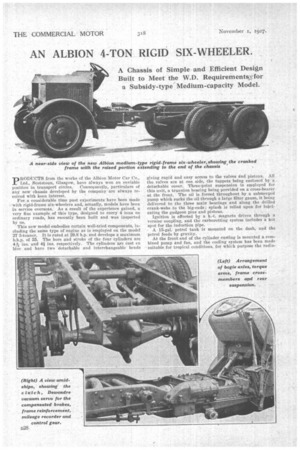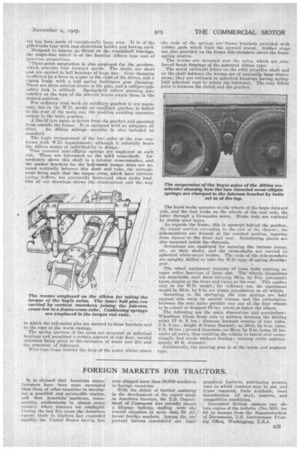AN ALBION 4-TON RIGID SIX-WHEELER.
Page 46

Page 47

If you've noticed an error in this article please click here to report it so we can fix it.
pRODUCTS from the works of the Albion Motor Car Co., _E Ltd, Scotstoun, Glasgow, have always won an enviable
position in transport circles. Consequently, particulars of any new chassis developed by the compaily are always received with keen interest.
For a considerable time past eXperiments have been made with rigid-frame six-wheelers and, actually, models have been in service overseas. As a result of the experience gained, a very fine example of this type, designed to carry 4 tons on ordinary roads, has recently been built and was inspected by us.
• This new model embodies certain well-tried components, including the same type of engine as is employed on the model 27 3-tonner. It is rated at 29.8 b.p. and develops a maximum b.h.p. of 55. The bore and stroke of the four cylinders are 4i1 ins. and 41 ins. respectively. The cylinders are cast en bloc and have two detachable and interchangeable heads
giving rapid and easy access to the valves find pistons. All the valves are at one aide, the tappets being enclosed by a detachable cover. Three-point suspension is employed for this unit, a trunnion bearing being provided on a cross-bearer at the front. The oil is forced throughout by a submerged pump which sucks the oil through a large filter gauze, it being delivered to the three main bearings and along the drilled crank-webs to the big-ends; splash is relied upon for lnri eating the gudgeon pins and pistons.
Ignition is effected by a h.-t. magneto driven through a vernier coupling, and the carburetting system includes a hot spot for the induction pipe.
• A 15-gal, petrol tank is mounted on the dash, and the petrol feeds by gravity. • At the front end of the cylinder casting is mounted a combined pump and fan, and the cooling system has been made suitable for tropical conditions, for which purpose the radia
tor line been made of exceptionally large area. It is orthe gilled-tube type with cast-aluminium header and bottom tank.
Designed to impose no thrust on the crankshaft bearings, the el/Ade-disc thatch is of the familiar Albiem type and of 'generous proportions.
17iiree-point suspension is also employed dot the gearbox, which, provides four forward speeds. The shafts are short and are carried in ball bearings -of large size. Gear changing is effected by -a lever in a gate at 'the right -of the driver, and a detch brake with a leaf spring facilitates gear changing. There are three selector levers in the gate, and a calliper-type
safety lock is utilized. Spring-held rollers pressing into notches on the tops of the selector levers retain the-se in the desired position.
For ordinary road work an auxiliary gearbox is not necessary, but in the W.D. model an auxiliary gearbox is bolted to the rear of the main one, the position avoiding excessive torque in the main gearbox.
A David tyre pump is driven from the gearbox and operated from outside the frame: It is equipped with an adequate oil An Albion mileage recorder is also included as standard. • The begie arrangement of the two axles at the rear conforms with W.D. requirements, although it naturally beaks the Albion stamp of individuality in design.
Two inverted semi-elliptic springs are .employed at each side. These are fillet-mud on the solid tress-Shaft. Immediately above this shaft is a tubular cross-member, and the anchor leteeekets for the ball-ereled torgue arms are see eueeel vertically between this shaft and tube, the arrangement being such that the tongue urine, which have intermit sluing buffers, are practically horizontal when under load. One of our drawings ,shows the construction and the way
in which the pall-ended pins are secured to these brackets and to the tops of the warm casings.
The spring carriers of the axles are mounted on spherical bearings and permitted a certain amount of side float, careful attention being given to the exclusion of wat6r and dirt and the retention of lubricant. .
Wire-rope loops restrict the drop of the axles, whilst above
the endsof the springs are 'frame 'brackets provided with rubber pads which limit the upward travel. Rubber stops are also provided on the frame side-members above the frontspr in gnt re.s.
The worms are mounted over the axles, which are ,reinforced banjo forgiegs of the patented Albion type:
The metal universal joints on the solid propeller shaft and on the shaft between the worms axe of unusually large ,direensieve; they are enclosed in spherical housings having springheld spherical caps to retain the lubricant. The only fabric joint is between the clutch and the gearbox.
The hand brake operates on the wheels of the bogie forward axle, and the foot brake on the wheels of the rear axle, the latter through a Dewandre servo. Brake rods are replaced by double steel thee& As regards the frame, this is upswept behind the gearbox, the raised portion extending to the end of the chassis; the side-members are deepest at -the cranked portion, tapering from thence to the front and rear. Reinforcing plates are also mounted inside the channels.
Serrations are employed for securing the various levers, etc., on their shafts, and the cross-shafts are carried in spherical white-metal bushes. The ends of the side-members are guitilbly drilled to take the W.1).-type of spring drawbar gear.
The wheel equipment consists of loose hubs running on taper roller bearings of large size. The wheels themselves are detachable steel discs carrying 36-in. by 0-in. pneumatic tyres, singles at the front and twins at the rear. This applies only to the W.D. model ; for ordinary use, the e-quipment would be 36-in. by 8-in. e.s. single pneumatics on all wheels.
Reverting to the springing, the rear springs are held against side sway by special clamps, and the articulation between the pear axles permits any one 'of the four wheels to be raised or dropped 10 ins, above or below the others.
The following are the main dimensions and particulars: Wheelbase (from front axle to midway between the driving axle) 12 ft. 6 ins_ ; distance between centres of rear axles, 3 ft. 9 ins.; height of frame (loaded), on 30-in. by 8-in. tyres, 2 ft. 10 ins.; ground clearance, on 36-in. by 8-in. tyres, 11. ins. under all axles, thus enabline' the vehicle to travel over exceptionally bad roads without fouling; turning circle approximately 48 ft. diameter.
Incidentally, the steering gear is of the worm and segment type.




































































































